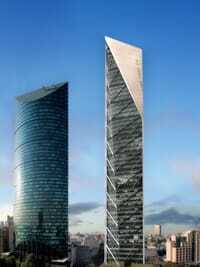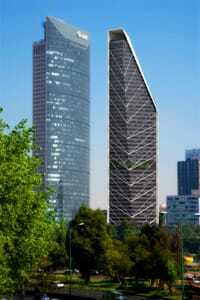Looking for real estate opportunities?
Head south of the border.
The real estate market in Mexico City is a vibrant and extremely active one that is open to entrepreneurs and investors, say ULI members there, who add that local knowledge is key to success.
“While the rest of the world is facing the results of overbuilding and unsold housing inventories, Mexico City continues to be underserved in most categories—residential, office, and retail,” says Gene Towle, managing partner at Softec, a global provider of IT and business process services in Mexico’s capital. “The city grows [by] 100,000 new households a year and requires at least a quarter of a million new jobs each year to keep up with new entrants into the workforce.”
Towle, a member of ULI Mexico’s executive council, notes there are currently more than 1,000 real estate projects active in the city. “There [is] at least 20 million square feet [1.8 million sq m] of new office space under construction that is scheduled to be on the market by late 2012 to mid-2014,” he continues. “Retail demand is 5 million square feet [464,515 sq m] a year and growing. The industrial market is transforming from manufacturing to distribution and demand is approximately 2 million to 4 million square feet [185, 806 to 371,612 sq m] per year. The residential market is worth about $8 billion a year and homebuilders currently have about a 60 percent share.”
As the most important market in the country, the real estate sector in Mexico City will continue to grow at a fast pace, says Patricio Gutierrez Tommasi, chief operating officer in the Mexico City office of Artha Capital, a Mexican real estate fund focused on buying and developing land for housing, retail, industrial, and tourism.
“There is a great move to do mixed-use developments and we see more and more of these projects coming on line in many parts of the city, with a great emphasis on green development and [the] sustainability approach both from the social, economic, and ecological points of view,” he adds. “On the office side, the Reforma corridor will see several new projects to be completed in the next six to 18 months.”
A number of new retail projects have started operations in Mexico City during the last six months, Gutierrez Tommasi continues. “The most important project, which opened in December, might be the new Paseo Interlomas in Interlomas—the first time in the last 20 years that three major department stores have opened in the same shopping center,” says Gutierrez Tommasi, who is vice chair of membership for ULI Mexico.
“For fashion malls, there might be one or two new Liverpool-anchored shopping centers opening in the next 18 months. Other than department store–anchored shopping centers, there are several neighborhood and power centers being built around the city. Still, the retail market has not fulfilled demand, and companies such as Wal-Mart, Soriana, and Chedraui are taking advantage of this. Although [these companies’] growth is more driven by market share rather than demographics, developers need to be cautious when analyzing absorption forecasts for smaller retail spaces in those projects.”
The most notable project is the new MRP, a Wal-Mart–anchored shopping center in Santa Fe, one of the few remaining “big” lots in that part of the city, Gutierrez Tommasi continues. “Movie operators Cinepolis and Cinemex are still trying to capture more audience in all parts of the city and Santa Fe alone will see two new movie complexes from each of them. Other than Santa Fe, high demographic markets are seeing either new centers or expansions of current ones.”
Old manufacturing areas north and east of downtown are starting to transform into mixed-use, high-rise developments. “These areas will probably be built out about 100 million square feet [9.3 million sq m] in the next five years,” Towle adds. “While demand remains strong, construction finance remains a serious issue. Office, retail, and industrial tend to be developed mostly with equity. This makes them very resistant to economic downturns, but investors require cash-on-cash returns in excess of 10 percent—thus, only the best projects get built and the market remains generally underserved.”
Housing is always needed in Mexico City. “Most projects are infill projects,” Gutierrez Tommasi says. “High-density vertical developments have great absorption rates, and, although with a limited market, middle-income and residential projects are still being developed in certain areas of the city.”
The Mexico City residential market has, until recently, depended on construction lending for its growth, but its traditional lenders—nonbank mortgage institutions—have seen their funding sources close, says Towle. “Unfortunately, high demand and soft financing for projects—the banking system in Mexico is dominated by international players—and real estate became a four-letter word in the U.S. and Europe after 2008,” he adds.
Rather than growing in the city, the industrial sector is moving to the outer rings of the city. “With the completion of new ring roads around Mexico City, access to better-located sites around the city has made it easier for logistics and distribution companies to locate outside,” Gutierrez Tommasi notes. “With this trend, centrally located large plots of land will be available for infill development of office, retail, and housing projects.”
Like many other municipalities, the city faces numerous challenges—particularly the 2012 election, which is when developers and end users will see what the new government’s views on development will be. “Hopefully, they will be proactive and continue support for a more planned and organized approach,” says Gutierrez Tommasi. “The other big challenge for development in the city is infrastructure issues, especially transportation. Mexico City is one of the biggest cities in the world, and no matter want you do [it] is never enough. It is hard to do well-planned urban development with those conditions.”
Anyone planning to invest in Mexico City should:
- Do adequate research. “Devote the time to visit, explore, ask questions, and look for deals, advises Towle.
- Team up with a local partner. Take the time to get to know the country, culture, and real estate market.
- Don’t expect immediate success. It takes time.
Watch: Video: Juan Diego Perez-Vargas on Transformation of Mexican Real Estate Markets




